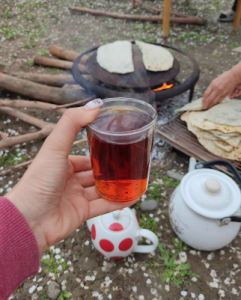
Tea
Vol 26, Issue 23, 12 April 2024
Tea is one of the oldest drinks in the world and is second only to water in popularity. The history of tea can be traced through various legends and tales of different peoples of the world, as well as references in official history. So, according to one of the legends, the second of the three Chinese Emperors of the San Juan Period, Shen Nong, in the III millennium BC, discovered tea quite by accident – the leaves of the plant fell into his cup with boiling water, and the resulting drink so impressed the emperor that the culture began to be cultivated throughout the country, as the emperor I personally issued a decree. Another legend tells how in ancient times shepherds noticed that animals, eating leaves from tea bushes, become cheerful and energetic. Therefore, they decided to prepare and try a drink from these leaves. The result shocked them – the drink turned out not only invigorating, but also incredibly tasty, and most importantly – healthy.

The official date of the International Tea Day is May 21, which was proclaimed by the UN General Assembly in 2019. However, there is another date — December 15th. It appeared as a result of the fact that this day was chosen to celebrate Tea Day at international public forums in Mumbai, India (2004) and Porto Alegre, Brazil (2005).
Surprisingly, all the numerous varieties of tea are made from the leaves of one plant — an evergreen tropical shrub of the camellia family Camelia sinensis. The taste and aroma of the varieties, and there are more than 1,500 of them, may vary depending on the region of growth, season, terroir, method of production and storage of raw materials. Depending on the degree of fermentation and the method of production, tea is divided into: black (also called red), green, yellow, white, oolong and Pu-erh. Tea is also classified by place of origin: Chinese, Indian, Ceylon, Japanese, Vietnamese, Turkish, etc. According to the type of mechanical processing, tea can be: bayh (loose), pressed (brick, tile, tableted), extracted (soluble).

The most famous tea tradition exists in the UK is five o’clock tea. The British had a hand in popularizing the drink — thanks to the East India Company, tea began to be supplied to Great Britain from China in the XVII century, but in 1833 trade was banned. The British were forced to start growing tea in their own colony — India, and then in Ceylon. The standard was black baikhovi tea. It is said that the people of England drink tea at least five times a day. But the most important one is the five o’clock one, which is certainly served with sandwiches, cakes and pastries, and the drink itself is often consumed with the addition of milk. In fact, such a tradition — drinking tea between lunch and dinner to satisfy hunger and not overeating in the evening, exists not only in the UK. In Italy, Spain, France, Argentina and other countries, such a meal is even called almost identically — meriendina, from the Latin word merenda (“deserved”). Of course, while waiting for dinner, you deserve to relax for a while and drink tea.
- New Year’s mood - 22nd November 2024
- Minimalism is a way of life. Where to begin? - 15th November 2024
- Why do you need an air humidifier? - 8th November 2024
